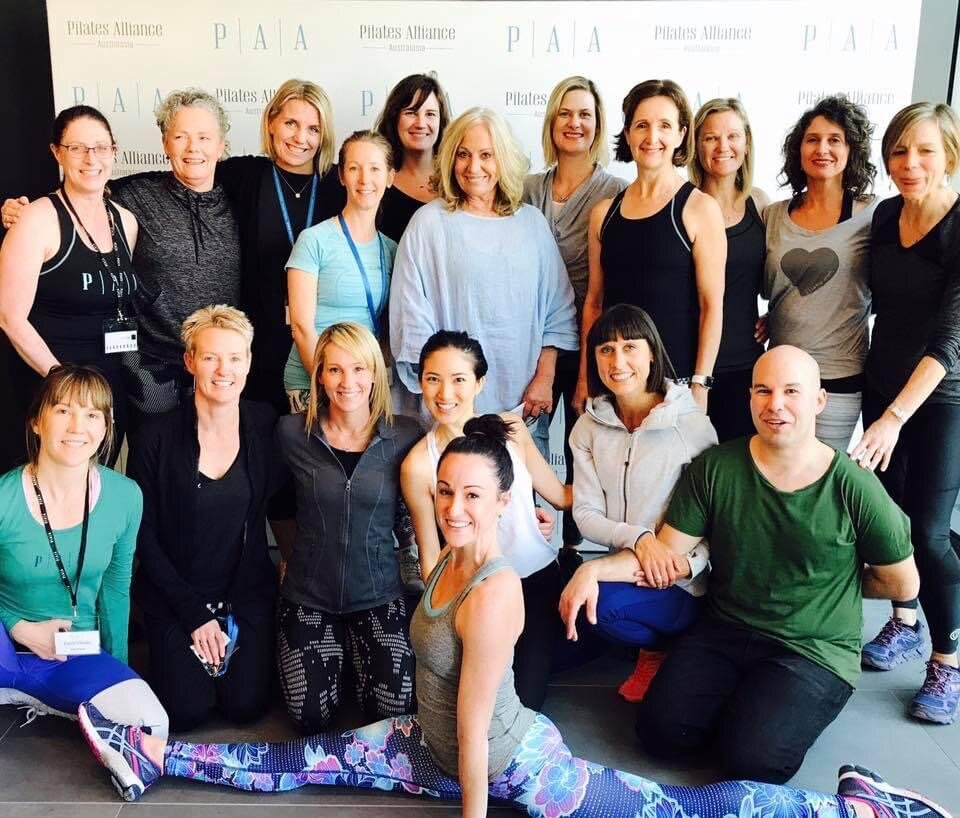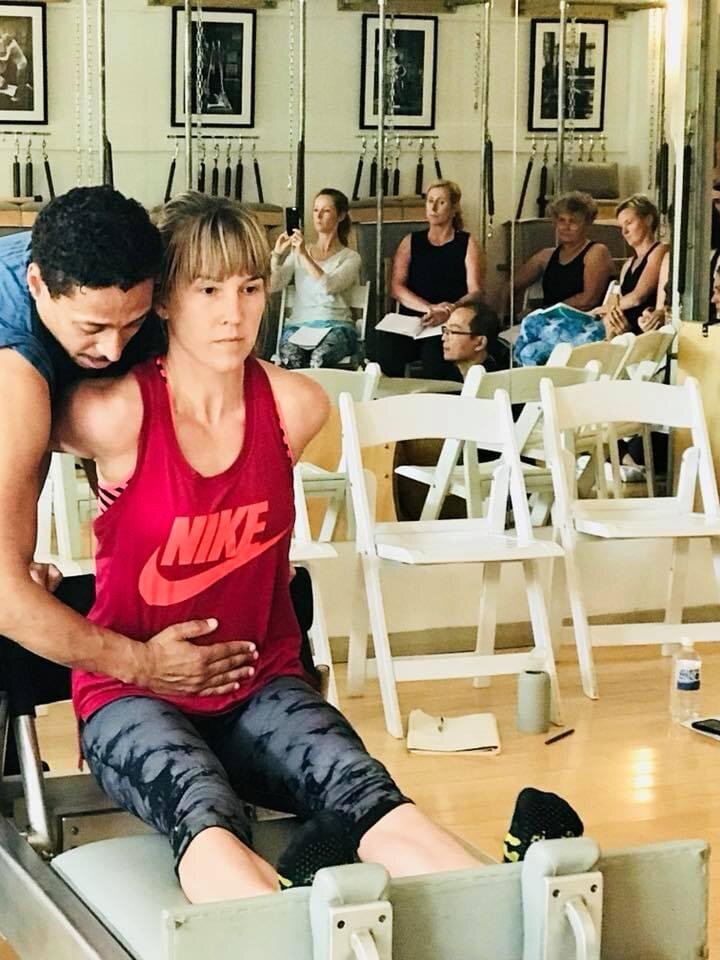It’s something I hear a lot.
“Pilates is expensive”.
So why is it ‘so expensive’?
Well firstly, becoming a Pilates Teacher does not happen over one weekend!
A full comprehensively trained Pilates Teacher has completed a training program that was likely around or upwards of the 600 hour mark.
Back in 2013 I did my APEI certification around full time work.
Some of the APEI crew from Sydney
This includes all the on the job training in the year or two it takes to complete their studies. Practicing on bodies, observations, self-mastery, anatomy training, the diploma certification, workshops and seminars.
A good Pilates Teacher will be registered with their national regulatory body (hello membership fees!) These organisations hold their members accountable and mandate the continuing education hours to at least 10 hours per calendar year. They have standards to maintain, which is a good thing. Plus Pilates teachers need to have their liability insurance in order to legally teach you, and their first aid and CPR.
Then there’s the cost of the equipment and props. Have you ever thought about buying a reformer? You’ll need to save your pretty pennies, because those things ain’t cheap, minimum for a half way decent one will be around $6000.
Doing a Pilates workshop with Jean Claude Nelson who had travelled from Munich, Germany. Obviously it was very serious by that look on my face!
Your Pilates Teacher does Pilates too! Yep, they must. In order to understand all the types of bodies, injuries, ailments and dysfunctions out there, they need to understand their own bodies. They will be having weekly privates (or semi-privates) with their mentor or teacher.
Still though, sometimes we can know all this and think ‘yeah but it’s just a fitness pursuit and I don’t like spending more then $x amount on fitness pursuits. It’s not like they make results happen overnight anyway’. Correct, results do not happen over night. I would be suspicious if they did. Change happens when we commit, show up, listen, reflect, learn, apply, on repeat, week after week after week.
Sometimes it’s easier to do things the way they’ve always been done. Maybe, you’ve only ever paid $60 a week for a gym membership where you get access to all the ‘bits’ a gym offers.
But how many times in a year do you hurt your back/knee/shoulder/hip and then go to the Osteo/Physio/Chiro/Massage to get fixed, feel better, go back to the gym and repeat the cycle. Now don’t get me wrong, I love my allied health professionals, they have helped me immensely over the years with managing my back condition (I have Spondylolisthesis). But I’m also trying to dig deeper into the root cause. Why is my body like this? What can I do to support it better? What needs to change to minimise the pain?
Chances are you didn’t have those niggling and repetitive injuries when you were younger, your body was different then, you didn’t sit at your desk or your car for so long, you didn’t have kids to pick up and run around after, you didn’t spend so long slumped on the couch at night.
You’ve changed, man.
But your perception of fitness pursuits has not.
We can’t expect different results, if we are doing the same thing over and over again.
If you are willing to spend money on fixing the problem, how about reviewing how you look at preventing the problem? Looking at your fitness pursuits through more of a health & wellbeing lens.
As we age, we notice more and more how our health impacts our wellbeing. When we feel healthy (in mind and body), we feel happy and more joyful. And when we are happy with more joyful experiences in life, we seek out and make choices with health at the forefront of our mind. It’s a two way street.
So how does Pilates help you experience more joy?
-Pilates helps to reduce pain points, aches and limitations so there are less restrictions on the way you move. With less restrictions, there are more opportunities to do the things you love and seek out those joyful experiences.
-Pilates does this by teaching you about alignment. Why and how we should stand tall. Pilates teaches you good posture and mindful habits to break the lifelong bad habits and non-helpful patterns our bodies do too much of.
-Pilates teaches you how to create space in the body so we can breathe better and fuller breaths.
-It teaches you how to build strength in ALL the muscles, not just the big ol’ dominant ones- hello quads and biceps, I’m looking at you guys having all the fun always!
-It teaches you the importance of active stretching throughout movement, not just passive stretching.
-It teaches you about your Powerhouse (not just your ‘core’ or stomach) and why building strength in your Powerhouse will create stability in your centre which allows you to do things for longer, with more efficiency, with less recovery time.
-Pilates teaches you how to hone your concentration skills. You have to actually think about where and what your muscles do to work properly for you. Which builds new pathways from brain to muscle so you can eventually automate good alignment, posture and muscle patterns. And as you practice this mind to muscle connection, it heightens your mindfulness, focus and clarity. It’s brain training, or as I like to put it, it’s Pilates Suduko.
With the strength and stamina you build in the mind and the body in your Pilates class, you build the strength, stamina and confidence in the ‘real world’. When you have more confidence and less aches, pains and niggles, you try more things, there’s less limitations on what you set out to achieve, you seek out those opportunities that fulfil you. You do those things you love with confidence in your body to get you through. You get to experience those moments of joy and so you feel happier, more balanced, calmer, kinder and it’s darned amazing. Just imagine if everyone was doing Pilates, what a world that might be.
So really, Pilates is more then just a fitness pursuit…
And I bet it doesn’t sound so expensive now.
Doing Pilates privately or semi-privately will give you and your teacher targeted one on one time to look at how your body moves, that will inform the way you practice, where the focus points will be, modifications, adaptations and specific progressions can be successfully integrated into a workout that will be challenging yet freeing for you and your body.
Yes there are other options of Pilates out there, larger, on mass classes means it may cost less for you. And some times that is perfectly fine for some bodies and some situations. It might be a wonderful way to exercise, but there will be no hands on, no targeted expertise for you body, no time to reframe or modify an exercise, no personal direction or touch and sometimes for some bodies, this can sometimes lead to a worsening of the thing you wanted to try and fix in the first place.
No body wants to feel worse after exercise.
You’ve heard Pilates is good for you. It’s not just me saying it. Maybe your Dr or Physio has suggested you need to work on your ‘core’. Just make sure you do your research. Interview your Pilates Teacher, as them if they have been comprehensively trained. Ask them if they have worked with back/shoulders/hip/knee problems before. Ask them if they have worked with postpartum clients. Ask them if they’ve worked with athletes. What ever you want to achieve in your body, be up front about it. The right teacher will be excited to work with you and your body and help bring your goals to life. The right teacher will ask you how your body feels at the beginning, during and after every session. They won’t be giving you a cookie cutter session plan for the average person, they will teach to the body in front of them, and that my friends, is worth it.






